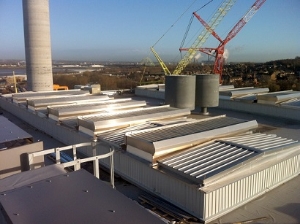 I recently wrote about my view that natural ventilation should always be the first choice for power generation facilities. This leads me to another common discussion point: the choice between wall louvres and roof ventilators for high level extract.
I recently wrote about my view that natural ventilation should always be the first choice for power generation facilities. This leads me to another common discussion point: the choice between wall louvres and roof ventilators for high level extract.
Common concerns for design teams and contractors over roof ventilators include maintenance, planning constraints and rain ingress. However, a high quality roof ventilator will be maintenance free, low profile and 100% watertight.
Why are roof ventilators better than wall louvres for high level extract?
- Roof ventilators are less likely to be adversely affected by wind pressures.
- Wall louvres are normally installed at least 1m below roof level, which creates an area of warm air pooling above this level.
- There is a greater stack effect with roof vents, which reduces the amount of ventilation you require.
- The Cv (aerodynamic coefficient) of a roof ventilator tends to be better than a wall louvre.
Performance: let’s look at the facts
Let’s compare performance by using the same project example as my previous blog : we have a typical biomass boiler hall with a 500kW heat load and with building dimensions of 10m wide x 20m long x 20m high:
- With a roof ventilator: 8.3m2 AvCv of ventilation would be required at high and low level.
- With a wall louvre: 9.1m2 AvCv of ventilation would be required at high and low level. This is because of the lower stack height.
Furthermore, the Cv of a roof ventilator tends to be better than a wall louvre - 0.4 would be reasonable for a roof ventilator and 0.3 for a wall louvre. Therefore the ventilation requirements would be:
- Roof ventilator - Low level louvre=27.6m2 (face area), roof ventilator = 20.75m2 (throat area).
- Wall louvre - Low level louvre=30.33m2 (face area), high level wall louvre = 30.33m2 (face area).
Conclusion: roof ventilators work better and save more
In this project example, using a roof ventilator would require 9% less equipment at low level and 31.5% less equipment at high level than using a wall louvre. Therefore we are talking about fewer openings in the walls, less steelwork required, lower cost, no warm air pooling at high level, and a reduced effect from wind pressures.
If you want to know more, you can find more information in our other articles on ventilation relating to power generation facilities.
 Graeme Clark is a Senior Consultant for Colt UK and specialises in the design and product application of energy efficient HVAC and smoke control systems.
Graeme Clark is a Senior Consultant for Colt UK and specialises in the design and product application of energy efficient HVAC and smoke control systems.

